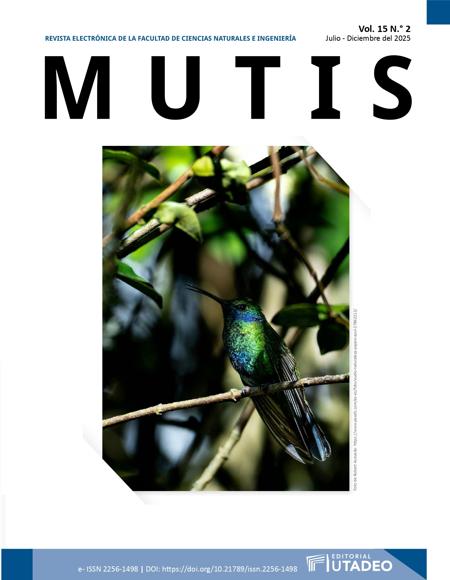
Esta obra está bajo una licencia internacional Creative Commons Atribución-NoComercial-CompartirIgual 4.0.
Esta obra está bajo una licencia internacional Creative Commons Atribución-NoComercial-CompartirIgual 4.0.
Resumen
El virus de la panleucopenia felina (fplv) es un agente infeccioso perteneciente al género Protoparvovirus, que afecta principalmente a felinos domésticos y silvestres, así como a otras especies de carnívoros. Se caracteriza por su alta estabilidad ambiental, siendo resistente a pH ácido y temperaturas elevadas, lo que favorece la transmisión por vía oro-fecal y mediante fómites contaminados. La enfermedad produce síntomas como leucopenia, vómitos, diarrea y depresión, especialmente en gatos jóvenes no vacunados, en quienes la mortalidad puede alcanzar hasta el 90%. Su genoma codifica las proteínas estructurales vp1 y vp2, fundamentales para la formación de la cápside, la infección viral y la respuesta inmune. El objetivo de este artículo fue compilar la información actualizada sobre la biología estructural, evolución y epidemiología del fplv, con énfasis en vp1 y vp2. Para ello se revisaron 53 artículos de los últimos 20 años indexados en Scopus, PubMed y Google Scholar, así como estudios sobre parvovirus estrechamente relacionados, en especial el parvovirus canino (cpv), cuyas similitudes permitieron extrapolaciones relevantes. Además de la revisión, se construyó un árbol filogenético a partir de secuencias representativas de VP2 utilizando el método Neighbor-joining (NJ), el cual confirmó que FPLV forma un clado monofilético estrechamente relacionado con las variantes CPV-2 y sus derivados, lo cual respalda su origen evolutivo común y ayuda a explicar la compartición de características estructurales y funcionales. Se destaca el papel de vp1 y vp2 en el reconocimiento del receptor de transferrina (TfR), la importancia de mutaciones en los loops de VP2 y en la evasión inmune. Asimismo, se resalta la importancia de herramientas in silico en la comprensión de la biología viral y en el desarrollo de vacunas. Estos enfoques sientan las bases para el estudio funcional de las proteínas de la cápside y una comprensión más profunda dirigida a terapias, prevención y conservación de especies domésticas y silvestres.
Citas
Akter, J., Nath, C., Hossain, M. S., & Ahaduzzaman, M. (2024). The coding complete genomic sequence of a feline panleukopenia virus detected from a do-mestic cat (Felis catus) in Chattogram, Bangladesh. Microbiology Resource An-nouncements, 13(8). https://doi.org/10.1128/mra.00209-24
Allison, A. B., Organtini, L. J., Zhang, S., Hafenstein, S. L., Holmes, E. C., & Parrish, C. R. (2015). Single Mutations in the VP2 300 Loop Region of the Three-Fold Spike of the Carnivore Parvovirus Capsid Can Determine Host Range. Journal Of Virology, 90(2), 753-767. https://doi.org/10.1128/jvi.02636-15
Awad, R. A., Khalil, W. K. B., & Attallah, A. G. (2018). Epidemiology and diag-nosis of feline panleukopenia virus in Egypt: Clinical and molecular diagnosis in cats. Veterinary world, 11(5), 578–584. https://doi.org/10.14202/vetworld.2018.578-584
Bär, S., Rommelaere, J., & Nüesch, J. (2013). Vesicular Transport of Progeny Parvovirus Particles through ER and Golgi Regulates Maturation and Cytolysis. PLoS Pathogens, 9(9), e1003605. https://doi.org/10.1371/journal.ppat.1003605
Barrs, V. R. (2019). Feline Panleukopenia. Veterinary Clinics Of North Ameri-ca Small Animal Practice, 49(4), 651-670. https://doi.org/10.1016/j.cvsm.2019.02.006
Battilani, M., Bassani, M., Forti, D., & Morganti, L. (2006). Analysis of the Evolution of Feline Parvovirus (FPLV). Veterinary Research Communications, 30(S1), 223-226. https://doi.org/10.1007/s11259-006-0046-4
Callaway, H. M., Feng, K. H., Lee, D. W., Allison, A. B., Pinard, M., McKenna, R., Agbandje-McKenna, M., Hafenstein, S., & Parrish, C. R. (2016). Parvovirus Capsid Structures Required for Infection: Mutations Controlling Receptor Recognition and Protease Cleavages. Journal Of Virology, 91(2). https://doi.org/10.1128/jvi.01871-16
Callaway, H. M., Welsch, K., Weichert, W., Allison, A. B., Hafenstein, S. L., Huang, K., Iketani, S., & Parrish, C. R. (2018). Complex and Dynamic Interactions be-tween Parvovirus Capsids, Transferrin Receptors, and Antibodies Control Cell Infec-tion and Host Range. Journal Of Virology, 92(13). https://doi.org/10.1128/jvi.00460-18
Chen, S., Liu, F., Yang, A., & Shang, K. (2024). For better or worse: crosstalk of parvovirus and host DNA damage response. Frontiers In Immunology, 15. https://doi.org/10.3389/fimmu.2024.1324531
Chung, H. C., Kim S. J., Nguyen V.G., Shin S, Kim J. Y., Lim S. K, Park, Y. H., Park, B. (2020). New genotype classification and molecular characterization of ca-nine and feline parvoviruses. J Vet Sci, 21(3): e43. https://doi.org/10.4142/jvs.2020.21.e43
Dang, T. T. M., Tran, T. T., Van, T. M., Le, Q. T., & Ngoc, B. T. (2023). First mo-lecular report of Feline panleukopenia virus infection in diarrheic cats at Can Tho City, Vietnam. Veterinary Integrative Sciences, 22(2), 631-643. https://doi.org/10.12982/vis.2024.043
Decaro, N., Desario, C., Miccolupo, A., Campolo, M., Parisi, A., Martella, V., Amorisco, F., Lucente, M. S., Lavazza, A., & Buonavoglia, C. (2008). Genetic analysis of feline panleukopenia viruses from cats with gastroenteritis. Journal Of General Virology, 89(9), 2290-2298. https://doi.org/10.1099/vir.0.2008/001503-0
De Medeiros Oliveira, I. V. P., De Carvalho Freire, D. A., Ferreira, H. I. P., Moura, G. H. F., Da Rocha, C. S., Calabuig, C. I. P., Kurissio, J. K., Araújo, J. P., Junior, & De Paula Antunes, J. M. A. (2018). Research on viral agents associated with feline reproductive problems reveals a high association with feline panleukopenia virus. Veterinary And Animal Science, 6, 75-80. https://doi.org/10.1016/j.vas.2018.06.004
Duarte, M. D., Henriques, A. M., Barros, S. C., Fagulha, T., Mendonça, P., Carvalho, P., Monteiro, M., Fevereiro, M., Basto, M. P., Rosalino, L. M., Barros, T., Bandeira, V., Fonseca, C., & Cunha, M. V. (2013). Snapshot of viral infections in wild carnivores reveals ubiquity of parvovirus and susceptibility of Egyptian mongoose to feline panleukopenia virus. PloS one, 8(3), e59399. https://doi.org/10.1371/journal.pone.0059399
Ge, S., Xu, L., Li, B., Zhong, F., Liu, X., & Zhang, X. (2020). Canine Parvovirus is diagnosed and neutralized by chicken IgY-scFv generated against the virus capsid protein. Veterinary Research, 51(1). https://doi.org/10.1186/s13567-020-00832-7
Giraldo-Ramirez, S., Rendon-Marin, S., & Ruiz-Saenz, J. (2020). Phylogenet-ic, Evolutionary and Structural Analysis of Canine Parvovirus (CPV-2) Antigenic Vari-ants Circulating in Colombia. Viruses, 12(5), 500. https://doi.org/10.3390/v12050500
Goetschius, D. J., Hartmann, S. R., Organtini, L. J., Callaway, H., Huang, K., Ba-tor, C. M., Ashley, R. E., Makhov, A. M., Conway, J. F., Parrish, C. R., & Hafenstein, S. L. (2021). High-resolution asymmetric structure of a Fab–virus complex reveals over-lap with the receptor binding site. Proceedings Of The National Academy Of Sciences, 118(23). https://doi.org/10.1073/pnas.2025452118
Goodman, L. B., Lyi, S. M., Johnson, N. C., Cifuente, J. O., Hafenstein, S. L., & Parrish, C. R. (2010). Binding Site on the Transferrin Receptor for the Parvovirus Capsid and Effects of Altered Affinity on Cell Uptake and Infection. Journal Of Virolo-gy, 84(10), 4969-4978. https://doi.org/10.1128/jvi.02623-09
Greene, C. E., & Addie, D. D. (2006): Feline Parvovirus Infections. In: Greene, C. E. (ed.), Infectious Diseases of the Dog and Cat, 3rd edn, pp. 78–88. Else-vier, St. Louis
Hafenstein, S., Palermo, L. M., Kostyuchenko, V. A., Xiao, C., Morais, M. C., Nelson, C. D., Bowman, V. D., Battisti, A. J., Chipman, P. R., Parrish, C. R., & Rossmann, M. G. (2007). Asymmetric binding of transferrin receptor to parvovirus capsids. Proceedings of the National Academy of Sciences of the United States of America, 104(16), 6585–6589. https://doi.org/10.1073/pnas.0701574104
Halder, S., Ng, R., & Agbandje-McKenna, M. (2012). Parvoviruses: Structure and Infection. Future Virology, 7(3), 253-278. https://doi.org/10.2217/fvl.12.12
Hoang, M., Wu, C., Lin, C., Nguyen, H. T. T., Le, V. P., Chiou, M., & Lin, C. (2020). Genetic characterization of feline panleukopenia virus from dogs in Vietnam reveals a unique Thr101 mutation in VP2. PeerJ, 8, e9752. https://doi.org/10.7717/peerj.9752
Inthong, N., Sutacha, K., Kaewmongkol, S., Sinsiri, R., Sribuarod, K., Sirina-rumitr, K., & Sirinarumitr, T. (2019). Feline panleukopenia virus as the cause of diar-rhea in a banded linsang (Prionodon linsang) in Thailand. Journal Of Veterinary Medi-cal Science, 81(12), 1763-1768. https://doi.org/10.1292/jvms.19-0238
Kabir, A., Habib, T., Chouhan, C. S., Hassan, J., Rahman, A. K. M. A., & Nazir, K. H. M. N. H. (2023). Epidemiology and molecular characterization of Feline panleu-kopenia virus from suspected domestic cats in selected Bangladesh regions. PLoS ONE, 18(10), e0282559. https://doi.org/10.1371/journal.pone.0282559
Kim, Y. J., Yoon, S., Jang, J. H., Jeong, D. G., Lee, B. J., & Kim, H. K. (2021). Ge-netic Characterization of Feline Parvovirus Isolate Fe–P2 in Korean Cat and Serologi-cal Evidence on Its Infection in Wild Leopard Cat and Asian Badger. Frontiers In Veter-inary Science, 8. https://doi.org/10.3389/fvets.2021.650866
Kolangath, S. M., Upadhye, S. V., Dhoot, V. M., Pawshe, M. D., Bhadane, B. K., Gawande, A. P., & Kolangath, R. M. (2023). Molecular investigation of Feline Panleukopenia in an endangered leopard (Panthera pardus) – a case report. BMC Veterinary Research, 19(1). https://doi.org/10.1186/s12917-023-03612-5
Lee, H., Callaway, H. M., Cifuente, J. O., Bator, C. M., Parrish, C. R., & Hafen-stein, S. L. (2019). Transferrin receptor binds virus capsid with dynamic motion. Proceedings Of The National Academy Of Sciences, 116(41), 20462-20471. https://doi.org/10.1073/pnas.1904918116
Li, S., Chen, X., Hao, Y., Zhang, G., Lyu, Y., Wang, J., Liu, W., & Qin, T. (2022). Characterization of the VP2 and NS1 genes from canine parvovirus type 2 (CPV-2) and feline panleukopenia virus (FPLV) in Northern China. Frontiers In Veterinary Science, 9. https://doi.org/10.3389/fvets.2022.934849
Li, J., Peng, J., Zeng, Y., Wang, Y., Li, L., Cao, Y., Cao, L., Chen, Q., Ye, Z., Zhou, D., Cao, S., & Li, Q. (2024). Isolation of a feline-derived feline panleukopenia virus with an A300P substitution in the VP2 protein and confirmation of its pathogenicity in dogs. Animal Diseases, 4(1). https://doi.org/10.1186/s44149-023-00108-5
Liang, R., Liang, L., Zhao, J., Liu, W., Cui, S., Zhang, X., & Zhang, L. (2022). SP1/miR-92a-1–5p/SOCS5: A novel regulatory axis in feline panleukopenia virus replication. Veterinary Microbiology, 273, 109549. https://doi.org/10.1016/j.vetmic.2022.109549
Liu, C., Liu, Y., Liu, D., Qiu, Z., Tian, J., Guo, D., Li, Z., Liu, M., Li, Y., & Qu, L. (2015). Complete Genome Sequence of Feline Panleukopenia Virus Strain HRB-CS1, Isolated from a Domestic Cat in Northeastern China. Genome announcements, 3(2), e01556-14. https://doi.org/10.1128/genomeA.01556-14
Löfling, J., Lyi, S. M., Parrish, C. R., & Varki, A. (2013). Canine and feline par-voviruses preferentially recognize the non-human cell surface sialic acid N-glycolylneuraminic acid. Virology, 440(1), 89-96. https://doi.org/10.1016/j.virol.2013.02.009
López-Astacio, R. A., Adu, O. F., Lee, H., Hafenstein, S. L., & Parrish, C. R. (2023). The Structures and Functions of Parvovirus Capsids and Missing Pieces: the Viral DNA and Its Packaging, Asymmetrical Features, Nonprotein Components, and Receptor or Antibody Binding and Interactions. Journal Of Virology, 97(7). https://doi.org/10.1128/jvi.00161-23
Mende, K., Stuetzer, B., Sauter-Louis, C., Homeier, T., Truyen, U., & Hart-mann, K. (2014). Prevalence of antibodies against feline panleukopenia virus in client-owned cats in Southern Germany. The Veterinary Journal, 199(3), 419-423. https://doi.org/10.1016/j.tvjl.2013.12.023
Mietzsch, M., Pénzes, J. J., & Agbandje-McKenna, M. (2019). Twenty-Five Years of Structural Parvovirology. Viruses, 11(4), 362. https://doi.org/10.3390/v11040362
Miranda, C., Vieira, M. J., Silva, E., Carvalheira, J., Parrish, C. R., & Thompson, G. (2016). Genetic Analysis of Feline Panleukopenia Virus Full-length VP2 Gene in Domestic Cats Between 2006-2008 and 2012-2014, Portugal. Transboundary And Emerging Diseases, 64(4), 1178-1183. https://doi.org/10.1111/tbed.12483
Niskanen EA, Kalliolinna O, Ihalainen TO, Hakkinen M, Vihinen-Ranta M (2013). Mutations in DNA binding and transactivation domains afect the dynamics of parvovirus NS1 protein. J Virol, 87:11762–11774. https://doi.org/10.1128/JVI.01678-13
Ohshima, T., & Mochizuki, M. (2009). Evidence for Recombination Between Feline Panleukopenia Virus and Canine Parvovirus Type 2. Journal Of Veterinary Medical Science, 71(4), 403-408. https://doi.org/10.1292/jvms.71.403
Paul, B., Alam, J., Hossain, M. M. K., Hoque, S. F., Bappy, M. N. I., Akter, H., Ahmed, N., Akter, M., Zinnah, M. A., Das, S., Mia, M. M., Parvej, M. S., Sarkar, S., Ghosh, H., Hasan, M., Ashour, H. M., & Rahman, M. M. (2023). Immunoinformatics for Novel Multi-Epitope Vaccine Development in Canine Parvovirus Infections. Biomedi-cines, 11(8), 2180. https://doi.org/10.3390/biomedicines11082180
Porporato, F., Horzinek, M. C., Hofmann-Lehmann, R., Ferri, F., Gerardi, G., Contiero, B., Vezzosi, T., Rocchi, P., Auriemma, E., Lutz, H., & Zini, E. (2018). Survival estimates and outcome predictors for shelter cats with feline panleukopenia virus infection. Journal of the American Veterinary Medical Association, 253(2), 188–195. https://doi.org/10.2460/javma.253.2.188
Ros, C., Bayat, N., Wolfisberg, R., & Almendral, J. (2017). Protoparvovirus cell entry. Viruses, 9(11), 313. https://doi.org/10.3390/v9110313
Truyen, U., & Parrish, C. R. (1992). Canine and feline host ranges of canine parvovirus and feline panleukopenia virus: distinct host cell tropisms of each virus in vitro and in vivo. Journal Of Virology, 66(9), 5399-5408. https://doi.org/10.1128/jvi.66.9.5399-5408.1992
Truyen, U., Addie, D., Belák, S., Boucraut-Baralon, C., Egberink, H., Frymus, T., Gruffydd-Jones, T., Hartmann, K., Hosie, M. J., Lloret, A., Lutz, H., Marsilio, F., Pen-nisi, M. G., Radford, A. D., Thiry, E., & Horzinek, M. C. (2009). Feline Panleukopenia: ABCD Guidelines on Prevention and Management. Journal Of Feline Medicine And Surgery, 11(7), 538-546. https://doi.org/10.1016/j.jfms.2009.05.002
Truyen, U., & Parrish, C. R. (2013). Feline panleukopenia virus: Its interest-ing evolution and current problems in immunoprophylaxis against a serious patho-gen. Veterinary Microbiology, 165(1–2), 29–32. https://doi.org/10.1016/J.VETMIC.2013.02.005
Tuzio, H. (2021). Feline Panleukopenia. In Infectious Disease Management in Animal Shelters, Second Edition. https://doi.org/10.1002/9781119294382.ch15
Wei, J., Shi, Y., Wang, X., He, S., Qi, X., Lu, R., Gao, Y., Liu, Z., Wang, Y., Wu, Y., & Jin, Y. (2024). The first outbreak of feline panleukopenia virus infection in captive Pallas’s cats in Xining Wildlife Park. Frontiers In Veterinary Science, 11. https://doi.org/10.3389/fvets.2024.1418553
Xie, Q., Wang, J., Gu, C., Wu, J., & Liu, W. (2023). Structure and function of the parvoviral NS1 protein: a review. Virus Genes, 59(2), 195-203. https://doi.org/10.1007/s11262-022-01944-2
Xue, H., Hu, C., Ma, H., Song, Y., Zhu, K., Fu, J., Mu, B., & Gao, X. (2023). Isola-tion of feline panleukopenia virus from Yanji of China and molecular epidemiology from 2021 to 2022. Journal Of Veterinary Science, 24(2). https://doi.org/10.4142/jvs.22197
Yang, D., Park, Y., Park, Y., An, S., Choi, S., Park, J., & Hyun, B. (2022). Isola-tion and molecular characterization of feline panleukopenia viruses from Korean cats. Korean Journal Of Veterinary Research, 62(1), e10. https://doi.org/10.14405/kjvr.20210050
Yeo, Y., Kim, H., Park, J., Kim, J., Shin, Y., Lee, K., Kwon, O., Jeoung, H., Kang, H., Ku, B., Park, S., Kwon, O., & Park, C. (2023). Epidemiological and Molecular Ap-proaches for a Fatal Feline Panleukopenia Virus Infection of Captive Siberian Tigers (Panthera tigris altaica) in the Republic of Korea. Animals, 13(18), 2991. https://doi.org/10.3390/ani13182991
Zhang, L., Zhao, J., Zhai, Z., Liang, L., Liang, R., & Cui, S. (2020). Cellular mi-croRNA, miR-1343-5p, modulates IFN-I responses to facilitate feline panleukopenia virus replication by directly targeting IRAK1 gene. Veterinary Microbiology, 245, 108691. https://doi.org/10.1016/j.vetmic.2020.108691
Zhang, H., Zhang, W., Pan, Y., Li, H., He, T., Dong, Q., Song, W., Zhang, W., Zhang, L., Kareem, K., Jiang, S., & Sheng, J. (2024). Evolutionary Dynamics and Patho-genicity Analysis of Feline Panleukopenia Virus in Xinjiang, China. Microorganisms, 12(11), 2205. https://doi.org/10.3390/microorganisms12112205
Descargas
Datos de publicación
Perfil evaluadores/as N/D
Declaraciones de autoría
- Sociedad académica
- Universidad de Bogotá Jorge Tadeo Lozano
- Editorial
- Universidad de Bogotá Jorge Tadeo Lozano

 PDF
PDF
 FLIP
FLIP













